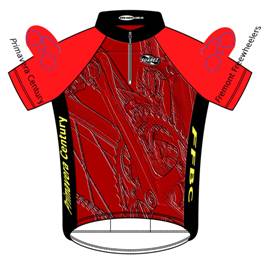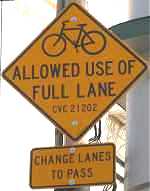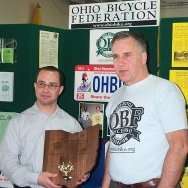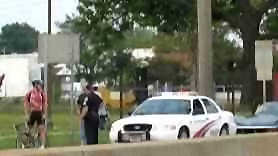
|
SPECIAL HAPPENINGS Announcement for Current Club Members, special Primavera 2008 Jersey Offer Expires March 3, 2008 Thanks to the hundreds of Primavera riders who bought our first-time-ever limited edition jersey. We were delighted at the response and positive comments. This jersey is a one time order and production run. The design is selected from our jersey design contest held last December.
For current FFBC members, the Jersey price is $45 each, a $10 savings. $55 for non-FFBC members. The jerseys are produced by Suarez with micro air-dry fabric (for rapid moisture evaporation), raglan sleeves, three back pockets and a 25 inch hidden zipper. Men’s and women’s styles are available. A note about Suarez sizes. The Suarez fit is snug, similar to a racer-cut. In fact, most folks who pre-ordered jerseys based on the size they normally wear opted to exchange up a size or two larger. This was true for many women, and particularly for men with broad shoulders and/or torsos. So, to help you determine the proper size to order, we took several measurements (in inches) of the Suarez jerseys in each size, by style. We recommend you measure your favorite-fitting jersey, compare the measurements and then decide which size to order. If you prefer a more comfortable, club-cut fit, select the next larger size.
Donations Committee Meeting Scheduled The Donations Committee will be having its meeting Tuesday, Feb. 19, 7:00 pm at Mission Coffee. This meeting is to decide what organizations will receive monetary donations from the FFBC. Two thousand dollars have been budgeted for this purpose for 2008. If you want a say in what organizations will be chosen, then please attend this meeting. The meeting is open to all club members. Those members attending the meeting will have the option of being on the committee and being able to vote on the choices. At a following club meeting, the choices will be presented to the general club membership present for a vote of approval or rejection. In the case of a rejection, the committee shall reconvene at a later date to decide on new recommendations. The complete details of the procedure can be seen on our website at: Bicycle Blunders and Smarter Solutions (final installment of the continuing article submitted by Wynn Kageyama)10. Smarter Solutions -- Traffic Law Reform and Enlightening Public Officials
Reforming Traffic Laws The work of the Law Reform Committee is available on the Web. At present there is preliminary information for a few states and for the UVC. The article includes instructions for anyone who wishes to help. At various times, state cycling organizations propose reforms for their state laws. Reforms proposed by the Ohio Bicycle Federation passed the Ohio General Assembly and signed into law in 2006. The reforms raised Ohio's rating from "D" to "B". Occasionally, state cycling organizations must mobilize to defeat proposed laws that would harm cyclists' interests. Examples include an attempt to mandate wrong-way riding in Montana (2001) or an exorbitant bicycle license fee proposed in Vermont (2003). Unfortunately, there is no national support for bike law reform efforts, except for the informal committee mentioned above.
At the local level, this author evaluated bicycle ordinances for 65 communities in NE Ohio assigning a rating (A-F scale) to each. Initially, about half of the communities mandated one or more dangerous practices, thus earning ratings of D or F. Since the project started some communities have improved their ordinances. Currently only one community (Brook Park) earns an A rating. The A rating is a result of the city completely revising their ordinances (originally rated F), and instead adopted Model Municipal Ordinances. Reforms started after a city resident sent a copy of the article to all members of council. The councilman who sponsored the reform legislation was quoted in the newspaper saying "I don't want to see Brook Park get an F in anything." The Ohio Bicycle Federation acknowledged the city's reforms by presenting a "Good Cycling Laws" award (photo at right). Characteristics of the Ideal Law: [2]
Enlightening Public OfficialsSince public officials come from our society, they are taught the same information, right or wrong, as other citizens. Overcoming popular myths about bicycle operation will help educate lawmakers, police, judges and engineers. There is a need to work specifically to reach these officials. Some states have similar instructions in the booklet given to applicants for a motor vehicle operator license. The Texas Drivers License Handbook has a particularly good section that tells motorists to watch for typical cyclists' mistakes and warns cyclists about motorist mistakes. Unfortunately, it is spoiled by misquoting the Texas "far right rule" to say "as far right in the lane as possible." Earlier (in Section 8) we mentioned the new Cyclist Friendly Community Program Toolkit. A very important feature of the program is that it strongly encourages government officials to understand the best cycling practices. Training Police
Cyclists need well-informed police to protect their safety and their rights under the law. Earlier in this series, we described problems due to poorly-trained police; including failing to enforce laws against the serious violations that cause collisions, occasional harassment of cyclists for what should be legal operation on the road and passing along misinformation in "safety tips", especially to children. There are some good bike training programs for police. Training for bicycle police is given by the International Police Mountain Bike Assoc. For other officers, we recommend the new National Police Bicycle Awareness Curriculum, developed through a grant from the National Highway Traffic Safety Administration. Police may also be able to arrange a seminar from a local certified BikeEd instructor. At minimum, show the Effective Cycling Video [3] to officers. Bicycle police can perform a very valuable educational service simply by being seen riding correctly on the roadway. Government Help
Not all actions by government are harmful. The basic "rules of the road" provide for orderly and efficient traffic flow that is extremely beneficial to cyclists. Because bicycles predate motor vehicles, the right for bicycle operation on the roads is well established in law. We have a few good examples of government officials working with knowledgeable cyclists. A few officials are enlightened themselves. We earlier mentioned the booklet “Bicycling Street Smarts” included in the bicycle driver manual in several states. Some local authorities produce useful materials as well [4]. The Ohio Legislature and governor worked with the Ohio Bicycle Federation to pass significant reforms in 2006. Legal Representation for CyclistsWhenever a cyclist needs legal help, whether to fight an unjust ticket, or to seek compensation from a collision caused by someone's negligence, the cyclist needs competent legal representation. This means an attorney and a good expert witness who understand cycling. Unfortunately, cyclists may not get equal rights under the law. Often legal counsel is unaware of how common attitudes and prejudices conflict with principles of engineering, safety and law. Sometimes this is because defendants try to economize on legal expense. You can learn from accounts of past cases in an article by this author, Bicycle "Right to the Road" Cases. More accounts of right to the road court cases are in the article The Right to Travel by Human Power and Alan Wachtel's essay, "Bicycles and the Law: The Case of California'. Some lawyers interested in cycling cases have their own web pages. You may be interested in the following.
Footnotes[1] Alan Forkosh photo. |





